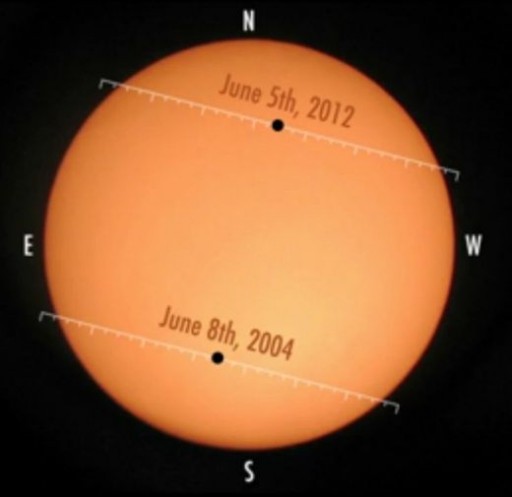The Transit of Venus June 5, 2012
by Kathy Watts on Jun.04, 2012, under Traditional Astrology
June 5, 2012 * The Transit of Venus
by Kathy Watts
When you stargaze in the daytime, you can see only one star — the Sun. On June 5, 2012, though, you can see something extra special. You can watch the planet Venus move between the Earth and the Sun as it drifts right across the face of our star.
Transits of Venus only happen when the orbits of the Earth and Venus are lined up exactly right. The orbit of Venus has to cross the ecliptic (the Sun’s path in the sky) and Venus must be exactly between the Sun and Earth (astronomers call this an inferior conjunction) at exactly the same time.
Since the disk of Venus is only 1/30th the size of the disk of the Sun, the planet doesn’t cover much. It looks like a large perfectly round sunspot drifting from one side of the Sun to the other. Basically, Venus is creating an annular eclipse of the Sun. It’s still exciting to actually see it happen.
These transits occur very rarely. Two transits will happen within eight years, then the next two transits won’t happen for another 100-plus years. After this 2012 transit, it won’t happen again until December 11, 2117.
In 1769, Captain James Cook sailed to Tahiti in the HMS Endeavour to observe the transit of Venus. People all over the world observed and carefully timed this transit. From their observations, the distance from the Sun to the Earth was first accurately calculated, giving us the real scale of the whole solar system. The distance from Sun to Earth is a very important number, with its own name, the astronomical unit (AU).
Only the inner planets Mercury and Venus can transit the Sun, as seen from Earth. If we were on Saturn, then Earth, Mars, and Jupiter would be able to transit the Sun, too.
Here in the East Bay, Venus will first touch the limb of the Sun at 3:06 pm. The Sun will set before Venus comes out the other side. Of all the United States, only Alaska and Hawaii will get to see the entire event.
To watch the transit of Venus, you need a safe way to look directly at the Sun. Filtered glasses (not ordinary sunglasses) or a projection screen can work. Check out Sunearthday.nasa.gov, or Transitofvenus.org, or even SkyandTelescope.com for observing tips on what you need to protect your eyes.
Easier maybe, you can go to UC Berkeley’s Lawrence Hall of Science. In the plaza they will have a full display and you can watch the whole thing.
Or, easier still, there’s going to be live webcast from the Mauna Kea Observatory atop the Mauna Kea volcano in Hawaii. Aloha, Venus!*
*We wish to thank Ella Levine, and the very generous people at http://firecrackerweekly.com for allowing us to reproduce Kathy Watts’ brilliant work on this very, rare astronomical event! Thank you!!

